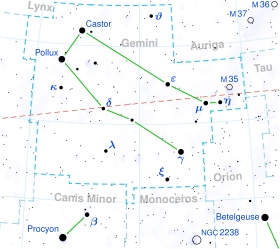
| |
| Observation data Epoch J2000 Equinox J2000 | |
|---|---|
| Constellation | Gemini |
| Right ascension | 07 46 07.45014 |
| Declination | +18° 30′ 36.0217″ |
| Apparent magnitude (V) | 4.89 |
| Characteristics | |
| Spectral type | K4 III |
| B−V color index | 1.425±0.034 |
| Astrometry | |
| Radial velocity (Rv) | +83.13±0.08 km/s |
| Proper motion (μ) | RA: −79.687 mas/yr Dec.: −53.551 mas/yr |
| Parallax (π) | 9.1500 ± 0.2963 mas |
| Distance | 360 ± 10 ly (109 ± 4 pc) |
| Absolute magnitude (MV) | −0.19 |
| Orbit | |
| Period (P) | 1,519.7±1.7 d |
| Semi-major axis (a) | ≥ 142±3 Gm |
| Eccentricity (e) | 0.325±0.015 |
| Periastron epoch (T) | 41,584±11 MJD |
| Argument of periastron (ω) (secondary) | 73±3° |
| Semi-amplitude (K1) (primary) | 7.21±0.13 km/s |
| Details | |
| 81 Gem A | |
| Mass | 1.22 M☉ |
| Radius | 33.7+2.0 −1.7 R☉ |
| Luminosity | 287.3±10.5 L☉ |
| Surface gravity (log g) | 1.94 cgs |
| Temperature | 4,095+109 −115 K |
| Metallicity | −0.18±0.06 dex |
| Age | 6.32 Gyr |
| Other designations | |
| g Gem, 81 Gem, BD+18°1733, FK5 1200, GC 10456, HD 62721, HIP 37908, HR 3003, SAO 97221, WDS J07461+1831AB | |
| Database references | |
| SIMBAD | data |
81 Geminorum is a binary star system in the northern constellation of Gemini. It has the Bayer designation g Geminorum, while 81 Geminorum is its Flamsteed designation. This system is visible to the naked eye as a faint, orange-hued point of light with an apparent visual magnitude of 4.89. The pair are located approximately 360 light years away from the Sun, based on parallax, and are moving further away with a radial velocity of +83 km/s, having come to within an estimated 164 light-years of the Earth nearly a million years ago. 81 Geminorum lies close enough to the ecliptic to undergo lunar occultations.
The variable velocity of this system was first suspected at the Dominion Astrophysical Observatory in 1921, then confirmed by the Lick Observatory in 1922. It is a single-lined spectroscopic binary with an orbital period of 4.2 years and an eccentricity of 0.325. The visible component is an aging giant star with a stellar classification of K4 III, having exhausted the supply of hydrogen at its core then expanded to 34 times the Sun's radius. It is over six billion years old with 1.22 times the mass of the Sun. This is a candidate alpha-enhanced star that displays a significant overabundance of silicon. The star is radiating around 287 times the Sun's luminosity from its bloated photosphere at an effective temperature of 4,095 K.
References
- ^ Brown, A. G. A.; et al. (Gaia collaboration) (August 2018). "Gaia Data Release 2: Summary of the contents and survey properties". Astronomy & Astrophysics. 616. A1. arXiv:1804.09365. Bibcode:2018A&A...616A...1G. doi:10.1051/0004-6361/201833051. Gaia DR2 record for this source at VizieR.
- ^ Anderson, E.; Francis, Ch. (2012), "XHIP: An extended hipparcos compilation", Astronomy Letters, 38 (5): 331, arXiv:1108.4971, Bibcode:2012AstL...38..331A, doi:10.1134/S1063773712050015, S2CID 119257644.
- ^ Keenan, P.; McNeil, R. (October 1989), "The Perkins catalog of revised MK types for the cooler stars", Astrophysical Journal Supplement Series, 71: 245–266, Bibcode:1989ApJS...71..245K, doi:10.1086/191373.
- ^ Griffin, R. F. (September 1982), "Photoelectric radial velocities. Paper IX. The orbits of the spectroscopic binaries 81 and chi Gem", Monthly Notices of the Royal Astronomical Society, 200: 1161–1168, Bibcode:1982MNRAS.200.1161G, doi:10.1093/mnras/200.4.1161.
- ^ Luck, R. Earle (2015), "Abundances in the Local Region. I. G and K Giants", The Astronomical Journal, 150 (3): 88, arXiv:1507.01466, Bibcode:2015AJ....150...88L, doi:10.1088/0004-6256/150/3/88, S2CID 118505114.
- Prugniel, Ph.; et al. (July 2011), "The atmospheric parameters and spectral interpolator for the MILES stars", Astronomy & Astrophysics, 531: A165, arXiv:1104.4952, Bibcode:2011A&A...531A.165P, doi:10.1051/0004-6361/201116769, S2CID 54940439.
- "81 Gem". SIMBAD. Centre de données astronomiques de Strasbourg. Retrieved 19 August 2017.
- Eggleton, P. P.; Tokovinin, A. A. (September 2008), "A catalogue of multiplicity among bright stellar systems", Monthly Notices of the Royal Astronomical Society, 389 (2): 869–879, arXiv:0806.2878, Bibcode:2008MNRAS.389..869E, doi:10.1111/j.1365-2966.2008.13596.x, S2CID 14878976.
- Cassar, L.; et al. (March 1989), "Lunar Occultations of IRAS Point Sources, 1991--2000", Astrophysical Journal Supplement, 69: 651, Bibcode:1989ApJS...69..651C, doi:10.1086/191323.
- Franchini, M.; et al. (2004). "Synthetic Lick Indices and Detection of α-enhanced Stars. II. F, G, and K Stars in the -1.0 < [Fe/H] < +0.50 Range". The Astrophysical Journal. 613 (1): 312. Bibcode:2004ApJ...613..312F. doi:10.1086/422909. S2CID 250877375.
| Constellation of Gemini | |||||||||||||
|---|---|---|---|---|---|---|---|---|---|---|---|---|---|
| Stars |
| ||||||||||||
| |||||||||||||
| Star clusters |
| ||||||||||||
| |||||||||||||
| Galaxies |
| ||||||||||||
| |||||||||||||